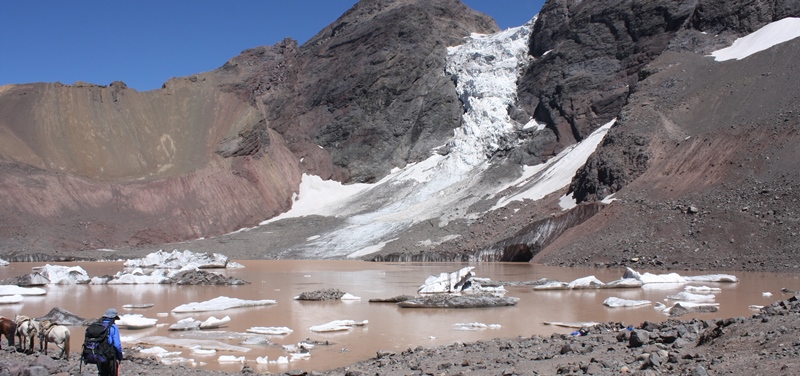Glacial lakes pose flood threat in Chile

The El Morado lagoon in the Central Andes lies 76km up river from the Chilean capital, Santiago
17 March 2017
Researchers from Aberystwyth and Exeter University are warning of the threat posed by glacial lakes in Chile.
Dr Ryan Wilson from Aberystwyth University and Dr Stephan Harrison from Exeter University returned from a field trip to Chile in February 2017.
Working in the remote Chileno Valley in Patagonia with Professor John Reynolds from Reynolds International Ltd, they were able to see how Lake Chileno had flooded the area leaving the land scarred.
“A massive flood had just ripped the valley apart and we were shocked at the scale of the destruction. Any remaining trees were bent and twisted, and boulders the size of cars were scattered across the flood plain,” says Dr Wilson who is a post-doctoral research associate in the Centre for Glaciology at Aberystwyth’s Department of Geography and Earth Sciences.
“Luckily, this part of the Chileno Valley is uninhabited but there are other glacial lakes in Chile which could pose a real threat to populated areas. As a result of climatic warming, glacier ice melt production is increasing and meltwater lakes can burst through unstable ice or moraine barriers causing huge floods.”
Surveying the floodplain using drone aerial photography and measuring lake depth using a custom-built remote-controlled boat, the team were able to piece together clues as to what caused the flood and estimate landscape damage.
This information will help to improve the understanding of the physical processes associated with large Glacial Lake Outburst Floods (GLOFs) events in Chile.
The research team also visited the El Morado lagoon, which lies 76km upriver of the capital Santiago.
Even though there is no imminent flood risk to the city, researchers will be monitoring Morado using remote sensing to detect any sudden swells in water levels.
Dr Stephan Harrison from Exeter University said: “The El Morado lagoon is fed by a large hanging glacier snout and if that fell into the lake, there would be a pretty big wave. Such a flood event could threaten downstream mining and tourist facilities so we need to be vigilant.”
The research trip was part of an ongoing ‘Glacial Hazards in Chile’ project, which is funded by Research Council UK (RCUK), the Natural Environment Research Council (NERC) (UK) and CONICYT (Comisión Nacional de Investigación Científica y Tecnológica – Chile).
The aim is to assess the changing frequency and magnitude of glacial hazards, such as Glacial Lake Outburst Floods (GLOFs), in Chile under current and future global climate change.
The project leader is Professor Neil Glasser from Aberystwyth University: “As glaciers continue to retreat and thin in response to climate change the likelihood of potentially dangerous GLOF events in Chile may increase. There is a need therefore to develop regional frameworks in order to monitor and mitigate risk”.
The latest visit to Chile by Dr Wilson and his team has been featured in this week’s Science magazine.



